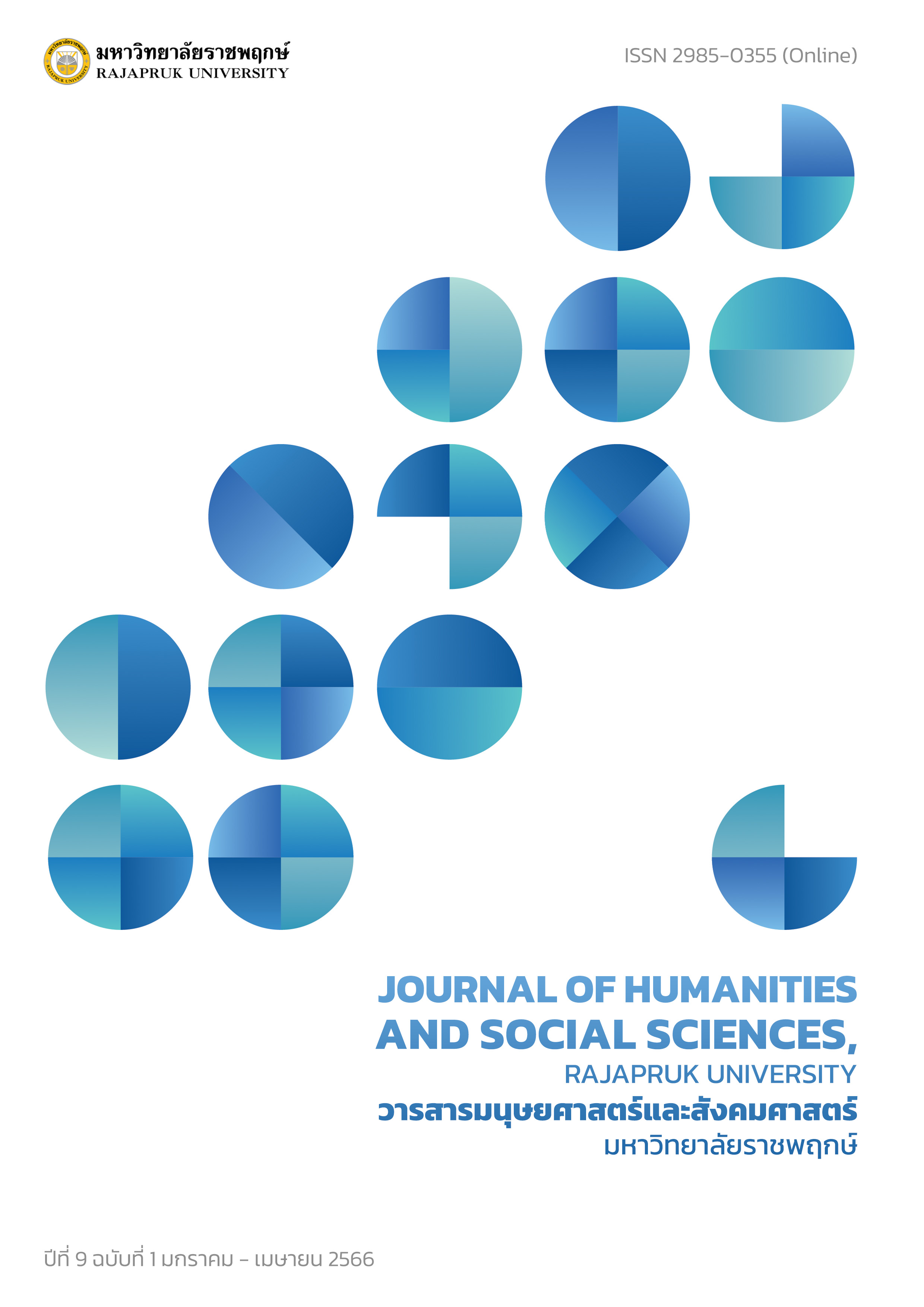The Model of Innovation Management of Private Hospital in Nakhon Pathom Province
Main Article Content
Abstract
The purposes of this research were to study 1) opinion level towards innovation management of private hospitals in Nakhon Pathom Province, and 2) the components of Innovation Management of Private Hospitals in Nakhon Pathom Province. The participants were collected from 165 of medical staff from private hospitals by using simple random sampling.The research instrument used a-5 rating scale with the reliability score of alpha coefficient at 0.98. The statistical data analysis were frequency, percentage, mean, standard deviation and confirmatory factor analysis (CFA).
The research findings found that the opinion level towards the innovation management model of private hospitals in Nakhon Pathom province was at the highest level. And the components of innovation management are: 1) the innovation input 2) the innovation process 3) the innovation output and 4) innovation external organization. The results of the structural validity test of innovation management of private hospitals in Nakhon Pathom Province model showed that Chi-square (χ2)=199.012, df=196, χ2/df (CMIN/DF)=1.015, RMR=.016, RMSEA=.000, GFI=.915, AGFI=.880, and CFI=0.999. Based on the findings, it indicated that innovation management of private hospitals in Nakhon Pathom Province model was consistent with empirical data significantly. As a result, private hospital administrators should prioritize developing the innovation process both inside and outside organizations and encourage personnel to develop and create innovations that are useful and can be applied in practice.
Article Details
References
กระทรวงการอุดมศึกษา วิทยาศาสตร์ วิจัยและนวัตกรรม. (2563). ทีเซลส์-โรงพยาบาลพญาไท-โรงพยาบาลเปาโล ร่วมกับหน่วยงานพันธมิตรภาครัฐภาคเอกชน พัฒนาโครงการปัญญาประดิษฐ์ สำหรับวิเคราะห์ภาพเอ็กซ์เรย์ทรวงอก. ค้นเมื่อวันที่ 7 ตุลาคม 2564, จาก https://www.mhesi.go.th/index.php/en/news-and-announce-all/news-all/1729-2020-07-02-05-47-24.html
กฤศกร จิรภานุเมศ สมนึก เอื้อจิระพงษ์พันธ์ และ พนิดา แช่มช้าง. (2554). ผลของการมุ่งเน้นความเป็นผู้ประกอบการและกลยุทธ์ที่มีต่อความสามารถทางนวัตกรรมและผลการดำเนินงาน การศึกษาเชิงประจักษ์ของบริษัทที่จดทะเบียนในตลาดหลักทรัพย์ เอ็ม เอ ไอ. วารสารวิทยาการจัดการ, 28(1): 1-15.
กัญญาวีณ์ โมกขาว สุจิตรา เหลืองอมรเลิศ นงลักษณ์ จินตนาดิลก และ เนตรชนก ศรีทุมมา. (2560). โมเดลความสัมพันธ์ระหว่างภาวะผู้นำการเปลี่ยนแปลงการสร้างความรู้ และผลการดำเนินงานการจัดการนวัตกรรมของหอผู้ป่วยโรงพยาบาลชุมชน. วารสารพยาบาลกระทรวงสาธารณสุข, 27(3): 163–175.
ชลภัสสรณ์ สิทธิวรงค์ชัย. (2560). ความสัมพันธ์เชิงสาเหตุและผลลัพธ์ในการจัดการนวัตกรรมเชิงกลยุทธ์; หลักฐานเชิงประจักษ์ของโรงพยาบาลเอกชนในประเทศไทย. วิทยานิพนธ์ปริญญาดุษฎีบัณฑิต มหาวิทยาลัยศิลปากร. ค้นเมื่อวันที่ 2 มกราคม 2564, จาก http://ithesis-ir.su.ac.th/dspace/bitstream/123456789/1647/1/57604928.pdf
นภดล เหลืองภิรมย์. (2557). การจัดการนวัตกรรม Innovation Management. กรุงเทพฯ: ดวงกมลพับลิชชิ่ง.
พยัต วุฒิรงค์. (2562). การจัดการนวัตกรรม: ทรัพยากร องค์การแห่งการเรียนรู้ และนวัตกรรม พิมพ์ครั้งที่ 2. กรุงเทพฯ: จุฬาลงกรณ์มหาวิทยาลัย.
พูลพงศ์ สุขสว่าง. (2557). หลักการวิเคราะห์โมเดลสมการโครงสร้าง. วารสารมหาวิทยาลัยนราธิวาสราชนครินทร์, 6(2): 136-145.
ลำพู สนั่นเอื้อ สุคนธ์ ไข่แก้ว และ สมพันธ์ หิญชีระนันท์. (2561). องค์ประกอบของภาวะผู้นำนวัตกรรมทางการพยาบาลตามการรับรู้ของพยาบาลวิชาชีพ ที่โรงพยาบาลเฉพาะทางมะเร็ง เขต 4 กรมการแพทย์ กระทรวงสาธารณสุข. วารสารโรงพยาบาลเจริญกรุงประชารักษ์. 14(2): 63-73.
วุฒิพงษ์ ภักดีเหลา. (2554). การศึกษาคุณลักษณะขององค์การนวัตกรรม: กรณีศึกษาองค์การที่ได้รับรางวัลด้านนวัตกรรม. วิทยานิพนธ์วิทยาศาสตรมหาบัณฑิต สถาบันบัณฑิตพัฒนบริหารศาสตร์. ค้นเมื่อวันที่ 2 มกราคม 2564, จาก http://libdcms.nida.ac.th/thesis6/2554/b175391.pdf
สำนักงานนวัตกรรมแห่งชาติ. (2553). การจัดการนวัตกรรมสำหรับผู้บริหาร. กรุงเทพฯ: กระทรวงวิทยาศาสตร์และเทคโนโลยี.
สำนักงานสาธารณสุขจังหวัดนครปฐม. (2562). ข้อมูลสถิติบุคลากรทางการแพทย์จังหวัดนครปฐม. ค้นเมื่อวันที่ 21 พฤศจิกายน 2563, จาก https://npt.hdc.moph.go.th/hdc/reports/report.php?source=pformated/format1.php&cat_id=c11dad88f80061c70cd1ae96b500d017&id=680c8ce3c9c0f0bd6d9734664ad4eb13
สุนทรีภรณ์ ทองไสย. (2559). พยาบาลกับการพัฒนาความคิดสร้างสรรค์. วารสารวิทยาลัยพยาบาลพระปกเกล้า. 27(1): 112-119.
อรุณี ไพศาลพาณิชย์กุล. (2559). การสร้างตัวแบบโรงพยาบาลนวัตกรรม: ระเบียบวิธีทฤษฎีฐานราก. วิทยานิพนธ์ปริญญาดุษฎีบัณฑิต สถาบันบัณฑิตพัฒน บริหารศาสตร์. ค้นเมื่อ 2 มกราคม 2564, จาก http://ssde.nida.ac.th/images/PDF/thesis_is/PhD/2559/arunee.pdf
Adair, J. (1996). Effective Innovation: How to Stay Ahead of the Competition. London: Pan Books.b4081061866744.html.
Deming, E. W. (1995). Out of the crisis. USA: The Massachusetts Institute of Technology Center for Advanced Engineering Study.
Greenberg, J. (2005). Managing Behavior in Organizations (4th ed). New Jersey: Pearson Prentice Hall.
Hair, J., Black, W., Babin, B., & Anderson, R. (2010). Multivariate data analysis a global perspective. New Jersey: Hamilton Printing.
Hamidi, F. & Gharneh, N. S. (2017). Impact of Co-creation on Innovation Capability and Firm Performance: A Structural Equation Modeling. Ad-minister, 30(1), 73-90. DOI: 10.17230/administer.30.4
Hooper, D., Coughlan. J., and Mullen M.R. (2008). Structural Equation Modeling: Guidelines for Determining Model Fit. Electronic Journal on Business Research Methods. 6(1): 53-60.
McGregor, J. 2008. The World's Most Innovative Companies. Bloomberg BusinessWeek. (April). Retrieved on November 24th, 2020, from http://www.businessweek.com/magazine/content/08_17/
Tidd, J. and Bessant, J. (2014). Management Innovation. 3th ed. West Sussex: Wiley.
Yamane, T. (1973). Statistic: An Introductory Analysis. 3th ed. New York: Harper &row.


